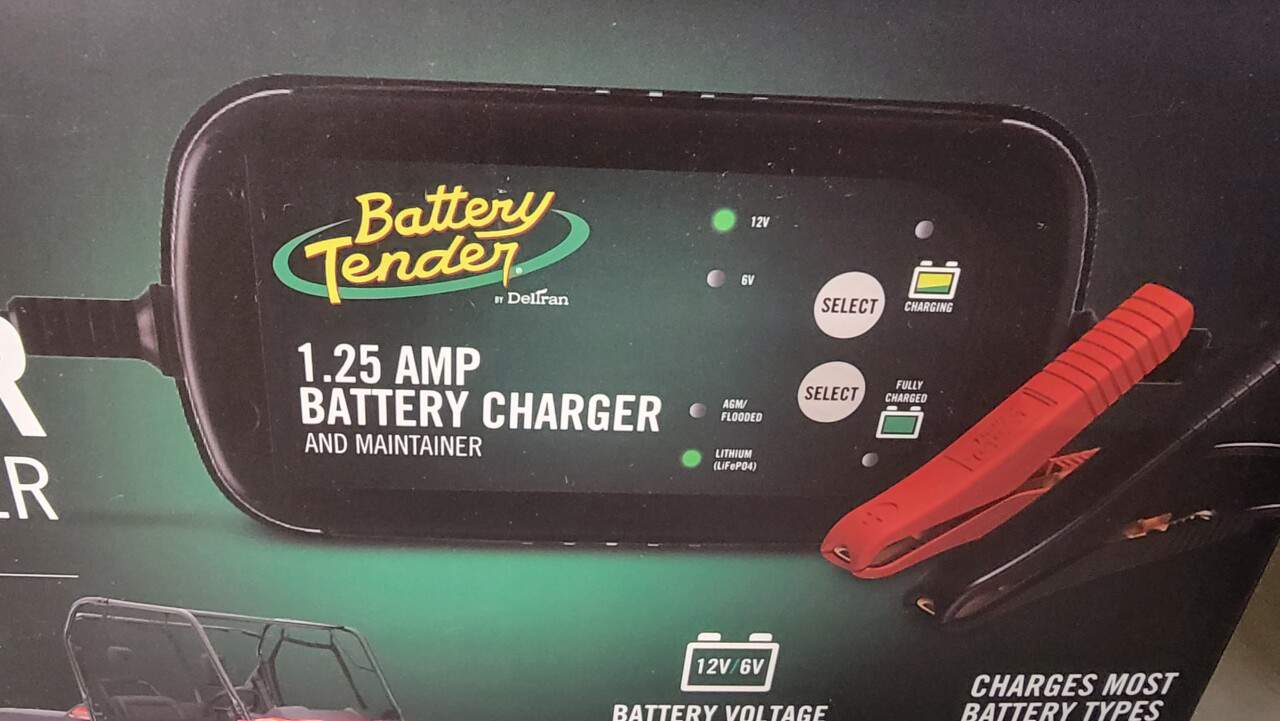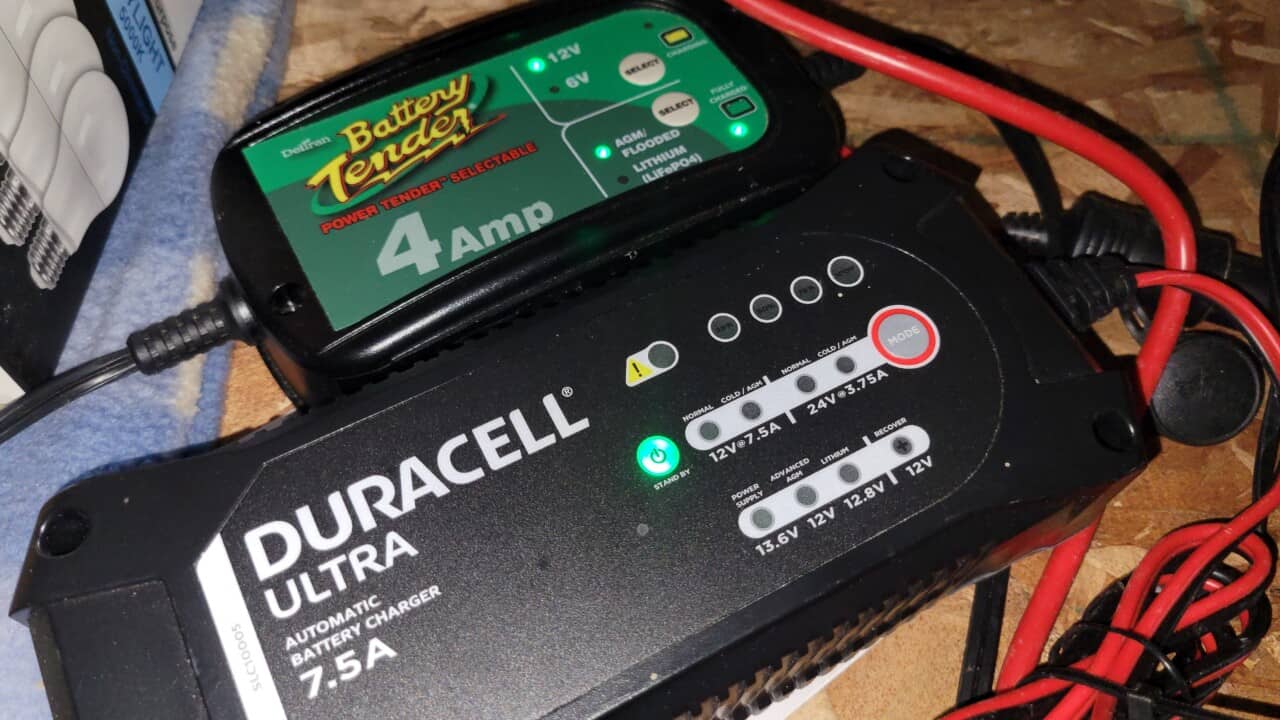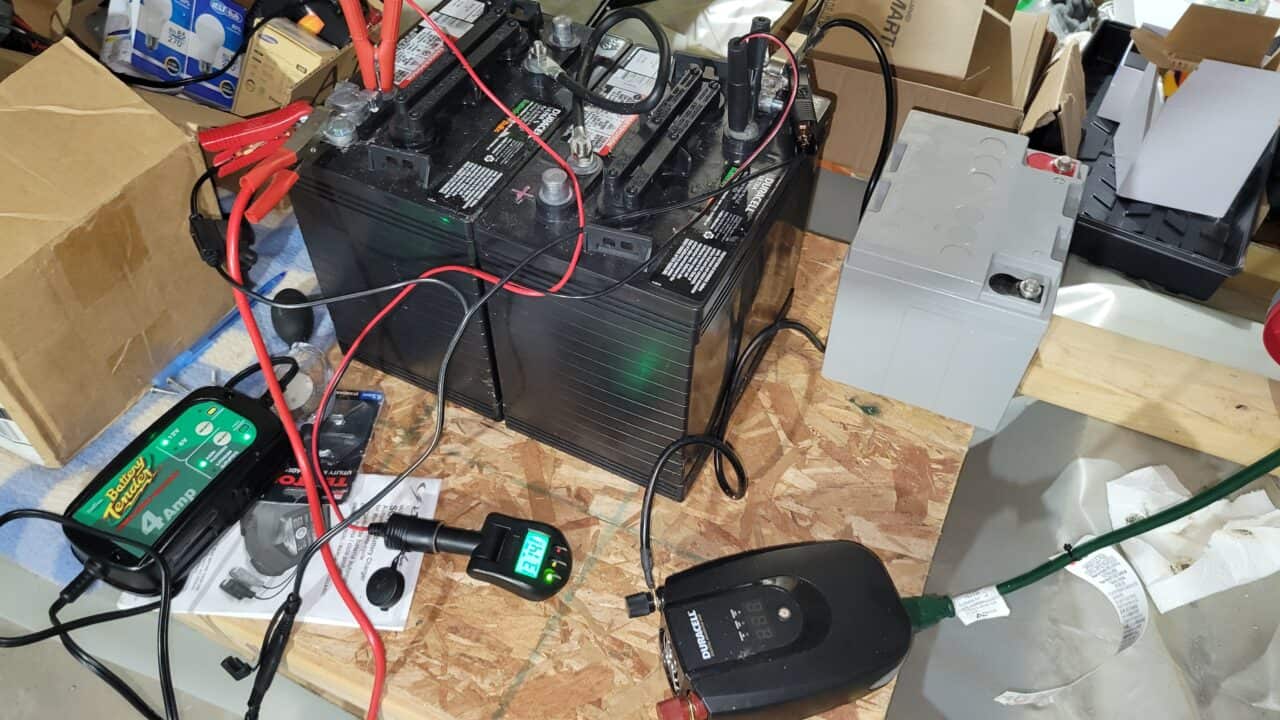There are small and subtle differences and similarities between float chargers and trickle chargers, and it’s important to know what those are before using one of them for a particular application. Let’s take a look at how these two types of chargers stack up, when to use each one, and which particular models you should use based on what type of battery you need to charge.
What is a Float Charger?
A float charger is typically a 3 or 4-stage smart charger which enters into the “float” stage when the battery is 95% complete with the charging process. These chargers can be of any amp rating for their bulk and absorption charging levels, but the float stage is always very low.
A float charger will typically have three amperage numbers on the charger itself. An example would be 15/5/1. The 15 would be the amps for the bulk stage, the 5 would be the amps for the absorption stage, and the 1 would be the float stage amperage. Some companies advertise the numbers in the reverse order. Just know that the highest number is for bulk and the lowest is for the float stage.
During the float stage of the charging process, the battery charger will keep the battery perfectly topped off at 100% state of charge without overcharging and damaging the battery. A float charger can be left connected to a battery indefinitely, but it is still a good idea to monitor the health of your battery every month or two by checking the cells for electrolyte levels and to ensure that the charger is not malfunctioning.

What is a Trickle Charger?
In its strictest definition, a trickle charger is typically a charger which is not multi-stage and only has a single, low amperage output. These chargers generally are 2-amps or less, with most of them being 1-amp or below.
These chargers emit a low amperage charge to gently charge a battery, are generally undersized for anything the size of a car battery or larger, but are adequately sized for charging motorcycle, generator, and lawn mower batteries.
Older model trickle chargers used to emit a low and steady charging current regardless of the state of charge of the battery, so if left connected after the battery was charge it would then start to overcharge and permanent damage would result.
Most newer trickle chargers are microprocessor controlled and will charge a battery to 100% and then turn back on when the battery’s voltage drops from that level. These newer trickle chargers can be left connected indefinitely, but it is still recommended to perform periodic maintenance on your batteries.
What is the Difference Between a Float and Trickle Charger?
While a float charger and a trickle charger both emit low charging currents, the trickle charger will only have a single amperage for charging a battery from 0% to 100%. A float charger typically has a high charging amperage for the bulk charging stage (0-80%), a mid range amperage for the absorption stage (80-95%), and a very low float charging stage current to top off a battery and keep it at 100% state of charge.

How Does a Float Charger Work?
When a battery is between 0% and 80% (10.5-12.5 volts), then a float charger will enter into the bulk charging stage. The highest advertised rating in your particular charger will be used while the battery is in this state of charge.
When the battery reaches 80% state of charge, the internal resistance builds inside the battery and the reaction inside the battery which converts electrical energy into stored chemical energy slows down. The amps of the charger drop in this stage to the second highest amp rating on your particular charger.
When the battery reaches 95-98% charged, the charger will enter into float mode which is where the amperage really drops and every last bit of electrical to chemical conversion potential is maximized. When the battery reaches 100%, the charger will either go into standby mode and wait for the battery to naturally self-discharge below a certain level, or it will match the battery’s self-discharge rate and essentially keep things at a perfect 100% without going over.
How Long Can You Float Charge a Battery?
In theory, you can float charge a battery indefinitely without issue. However, it is still highly recommended to check your battery’s setup every month or so to ensure that there are no issues with the charger or electrolyte levels.
Regular battery maintenance is still essential to maximize the lifespan of your battery, and keeping a float charger connected to the battery terminals when the battery is not in use is one of the best things you can do for your battery.
A float charger keeps a battery at 100% state of charge, which makes it impossible for lead sulfate crystals to form on the plates inside each of the battery’s cells. Lead sulfate increases internal resistance and inhibits the battery from charging properly and from giving off its maximum charge as well. Keeping your float charger connected is essential!

Will a Float Charger Charge a Dead Battery?
Float chargers typically have 2 or 3 higher amp ratings for charging a battery and simply enter into a float charge when the battery is nearly charged. This makes 3 and 4-stage float chargers excellent choices for charging a battery — even when it is dead.
The initial stage (bulk) will be charged at the highest amperage rating of the float charger, and it will decrease as the battery gets more and more charged until it finally enters into float mode at the end.
Will a Trickle Charger Charge a Dead Battery?
Trickle chargers tend to have only a single charging amperage and that amperage is typically very low since it is a trickle charger. It’s not uncommon to find a trickle charger with fractions of an amp on the market.
Trickle can certainly charge a dead battery but the battery generally has to be relatively small with regards to its Ah (ampere hour) rating on the sticker. The issue isn’t so much with the trickle charger not being able to physically do it with such a low charge, but rather the charger itself is microprocessor controlled and has an internal timer built into it.
If it doesn’t charge within the allotted time, then the charger will turn off and time out.
Each make and model will vary with regard to this timer. Let’s pretend we have a trickle charger with 750mA (or 0.75Amps) and the internal clock on this charger will cause it to stop charging if a full charge hasn’t been reached in 48 hours (2 days). This timer is built in for safety reasons, to prevent a charger from continuously charging a battery which might have an internal short and will never reach a full charge.
Let’s also pretend we’re trying to charge a 100Ah battery which is pretty much at 0% capacity. We will need to replenish 100Ah of that battery in this case. A charger will typically replenish about 0.85% of its rated amperage into the battery per hour.
Without getting into the complexities of battery science, we can just try to do some simple math:
100Ah / (0.75A x 0.85) = 157 hours to charge
If your charger times out after 48 hours, it will not fully charge this battery. You can try several charging sessions by unplugging the charger and plugging it back in to reset the clock and keep the charger charging.
Smaller batteries, like those used for lawn mowers, generators, and motorcycles can generally be charged and maintained with a trickle charger without a problem. With vehicle batteries, it’s best to get a 3-stage smart charger with a float mode with a base level amperage between 4 and 10.
Are Trickle Chargers Safe?
Modern trickle chargers are safe and you’d be hard pressed to find one anywhere that doesn’t automatically shut off when a battery reaches 100% state of charge. This ensures that your trickle charger will not overcharge your battery and boil off the electrolyte in each of the cells.
Antiquated chargers from several decades ago were certainly safe to use for charging, but they would not turn off when the battery was at maximum capacity and were unsafe to leave connected to the battery long-term. This resulted in electrical current being passed through the electrolyte solution when the battery could no longer accept it.
The electrical current would then cause electrolysis in each of the cells which is when electricity destroys water molecules and heat is generated. Over time, the electrolyte would evaporate out of the battery and expose the plates to air which would immediately cause them to oxidize and be irreversibly damaged.
Depending on the size of your battery and the amperage of your trickle charger, it could have certainly been possible to leave your battery hooked up to it for a couple weeks and return to a completely defective battery.
When looking for a trickle charger, just be sure it says something to the effect that is a charger and maintainer so that you know the charger will shut off when the battery is full.
Can You Overcharge a Battery with a Trickle Charger?
Modern trickle chargers which are microprocessor-controlled and serve as a “maintainer” will not allow the user to overcharge a battery. These chargers are safe to use for charging and safe to leave connected to your battery indefinitely.
Trickle chargers from several decades ago were safe to charge with but unsafe to leave connected to a battery after it was fully charged since the charger would continue to pump in electrical current when the battery could no longer accept it.
After a matter of days or weeks, the antiquated trickle chargers would boil off the electrolyte inside a battery and render it completely useless and beyond repair.
Can a Trickle Charger Ruin a Battery?
Nearly all trickle chargers on the market today are microprocessor controlled and are programmed to stop the charging current when the battery reaches 100% state of charge. Unless these trickle chargers are experiencing a programming malfunction, they will not ruin your battery if left connected for a long period of time.
Chargers from several decades ago can certainly ruin a battery since they were antiquated technology and wouldn’t turn off the charging current when the battery reached 100% state of charge. These trickle chargers would slowly overcharge the battery and boil out the electrolyte, which would permanently ruin the battery.
If you’re using a trickle charger that says something to the effect of “disconnect this charger when battery has completed its charging cycle”, then you know you’re dealing with antiquated technology and should be very cautious to not leave the trickle charger connected longer than is necessary to charge the battery.
Best Trickle and Float Chargers of 2023
| Battery Type | Typical Ah (Ampere Hour) Rating OR CCA | Recommended Float Charger Faster Option (Amazon) | Recommended Trickle Charger Best to maintain fully or near fully-charged batteries (Amazon) | Notes |
|---|---|---|---|---|
| Truck | 80-110 Ah | Noco 10 Amp | Noco 2 Amp | Float Charger recommended |
| SUV | 50-80 Ah | Deltran 5 Amp | Deltran 1.25 Amp | Float Charger recommended |
| Car | 40-60 Ah | Deltran 4 Amp | Deltran 1.25 Amp | Float Charger recommended |
| Marine Battery Deep Cycle (Boat) | 75-110 Ah | Mountable Deltran 5 Amp | Deltran 800mA | Float Charger recommended |
| Motorcycle | 10-14 Ah (@10hr) | Noco 2 Amp | Deltran 800mA | Float Charger recommended |
| Lawn Mower | 180-300 CCA | Noco 2 Amp | Deltran 800mA | |
| ATV | 18-35 Ah | Noco 2 Amp | Deltran 800mA | |
| Jet Ski | 2-10 Ah | Deltran 1.25 Amp | Deltran 800mA | |
| Golf Cart Deep Cycle | 150-225 Ah | Noco 10 Amp (12 and 6 Volt Options) | Deltran 4 Amp | Float Charger recommended. Often come in 6, 8 and 12 volt models. A pair of 6-volt batteries hooked in series is technically a 12-volt battery. Choose your charger accordingly. |
| Generator | 4-9 Ah | Noco 1 Amp | Deltran 800mA |
Trickle Charger for Generator Battery
Generators with automatic starting options (turn the key or push a button instead of pulling the recoil cord) will have a small, mounted, 12-volt battery near the bottom of the frame. All batteries will naturally self-discharge (lose their charge) by just sitting there doing nothing. After the better part of a year without being charged, don’t be surprised to find a dead battery attached to your generator.
The best option for these small batteries is something relatively small in charge so that you don’t overcharge the battery and damage it. It’s also best to get a charger that can be left hooked up to the battery indefinitely while the generator is not in use so that the battery will be ready to start it when the power goes out.
You can’t go wrong with the Noco 1 Amp charger and maintainer or even the Deltran 800mA which can both be found here on Amazon. They are simple to hook up and you can just “set it and forget it” once attached.

